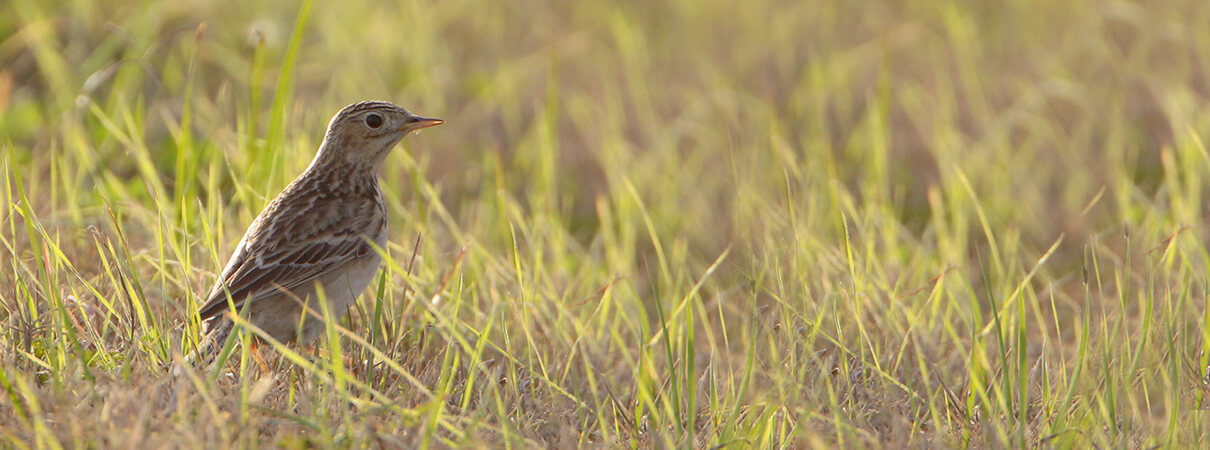
ABC works to prevent birds of conservation concern. such as the Golden-winged Warbler, Wood Thrush, and Long-billed Curlew, from becoming endangered. We do this by engaging landowners, partner groups, and other stakeholders to help improve the management of millions of acres of land in the U.S. and internationally.
ABC focuses on areas that we call BirdScapes, where conservation opportunities overlap with key habitat for birds, developing and implementing best management practices coupled with incentives to ensure that bird habitat is sustainably conserved.
While waterfowl and raptor populations have responded very positively to conservation action, most other groups of birds are still showing significant long-term declines, and a substantial increase in resources is needed to help these species follow waterfowl back to robust population levels. Many effective habitat conservation projects are demonstrating that this can be done, and some bird groups (such as grassland birds) are showing recent signs of positive response as a result.

Grassland birds have lost more than 50% of their population since 1970, according to data from the Breeding Bird Survey and Christmas Bird Counts. Sprague's Pipit by Greg Lavaty
Breeding Bird Survey and Christmas Bird Count data shows that since 1970, nearly all major groups of native wild birds have shown significant declines in population, cumulating in a nearly 3 billion overall loss of individual birds from the the U.S. and Canada.
These groups include: shorebirds with more a 37.4% loss, grassland birds a 53.3% loss, aerial insectivores a 31.8% loss, Arctic tundra species a 23.4% loss, western forest birds a 29.5% loss, arid land birds a 17% loss, boreal forest birds a 33.1% loss, and eastern forest birds a 17.4% loss. Thanks to strong conservation measures, wetland birds show an overall 13% gain.
Within these broad groupings, the U.S. WatchList further identifies 270 specific bird species and subspecies as being of particular conservation concern. Of these, ABC has so far made 65 species and subspecies priorities for program action.
ABC works to conserve bird species and subspecies of conservation concern as defined by the U.S. WatchList, and to aims to maximize the abundance and diversity of bird species – including the phenomenon of mass bird migration – by conserving habitat that benefits multiple bird species.
To accomplish this, ABC has initially identified 98 priority BirdScapes through which we are delivering, or plan to deliver, large landscape-scale habitat conservation projects to stabilize and restore migratory and other bird populations (ABC is currently active in 42 of these BirdScapes). These include breeding, stopover, and nonbreeding areas.
ABC plans to expand conservation across the broader landscape by adding additional BirdScapes and partners over time, and by piloting new approaches to conservation through habitat management recommendations coupled with financial incentives to leverage this work to the necessary scale.
In the U.S., ABC works extensively, though not exclusively, through and with Migratory Bird Joint Ventures (JVs) and their partners to conserve bird habitats. The total area with improved management conducted by JV partners in JVs where ABC staff play a significant role in planning and/or conservation delivery from 2007 to 2017 was over 6.4 million acres in the U.S. As of December 2021, this number had increased to 8.5 million.)
We also work with public and private landowners, and with forest management companies through the Sustainable Forestry Initiative to maintain and improve forest habitat for birds.
In addition, ABC works with partners in many parts of Latin America and the Caribbean to ensure healthy wintering and stopover habitat for migratory birds. For example, in 2021, ABC and Guatemalan partner FUNDAECO harvested the first crops from our shade-grown cardamom investment project in the Conservation Coast BirdScape. The project replaced cattle pastures with a mix of cardamom and native trees. Revenue generated from the sale of cardamom will be reinvested into the restoration of more degraded lands.
Due to space considerations, we provide specific metrics for six example BirdScapes that link from north to south across the lifecycles of representative “flagship” birds. BirdScapes typically include areas of pristine core habitat, areas that need restoration, areas under threat of habitat conversion, and areas in production that can be managed to contribute to bird conservation objectives. (To see a map of BirdScapes please see our spring 2017 magazine.)
Northern Great Plains – Northern Prairie BirdScape. Total Area: 19 million acres.
Flagship species: Long-billed Curlew
Chihuahuan Grasslands – Valles Centrales BirdScape. Total area: 4.85 million acres.
Minnesota – North Woods BirdScape. Total area: 6.5 million acres.
Flagship species: Golden-winged Warbler
Nicaragua – Northern Nicaraguan Highlands BirdScape. Total area: 1.15 million acres.
Pennsylvania – Poconos BirdScape. Total area: 462,959 acres.
Flagship species: Wood Thrush
Guatemala – Conservation Coast BirdScape. Total area: 1.21 million acres.